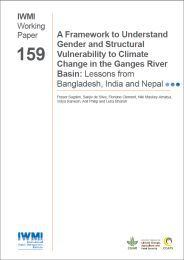A framework to understand gender and structural vulnerability to climate change in the Ganges River Basin: lessons from Bangladesh, India and Nepal
 As the reality of climate change becomes accepted in the scientific community, it is critical to continue to understand its impact on the ground, particularly for communities dependent on agriculture and natural resources. To do so, the analysis of vulnerability – in other words, the capacity of communities to cope with the effects of change – is critical. An extension of this is the analysis of social structures, and how they shape patterns of vulnerability and the capacity for individuals or groups to adapt. This review presents a framework for understanding structural vulnerability to climate change in the Ganges River Basin countries–Nepal, India and Bangladesh – with a focus on the role of gender in shaping vulnerability. This paper reviews the extensive academic and ‘gray’ literature from the region to identify a set of key economic and social inequalities which shape how men and women are differently affected by climate change and their capacity to adapt.
As the reality of climate change becomes accepted in the scientific community, it is critical to continue to understand its impact on the ground, particularly for communities dependent on agriculture and natural resources. To do so, the analysis of vulnerability – in other words, the capacity of communities to cope with the effects of change – is critical. An extension of this is the analysis of social structures, and how they shape patterns of vulnerability and the capacity for individuals or groups to adapt. This review presents a framework for understanding structural vulnerability to climate change in the Ganges River Basin countries–Nepal, India and Bangladesh – with a focus on the role of gender in shaping vulnerability. This paper reviews the extensive academic and ‘gray’ literature from the region to identify a set of key economic and social inequalities which shape how men and women are differently affected by climate change and their capacity to adapt.
